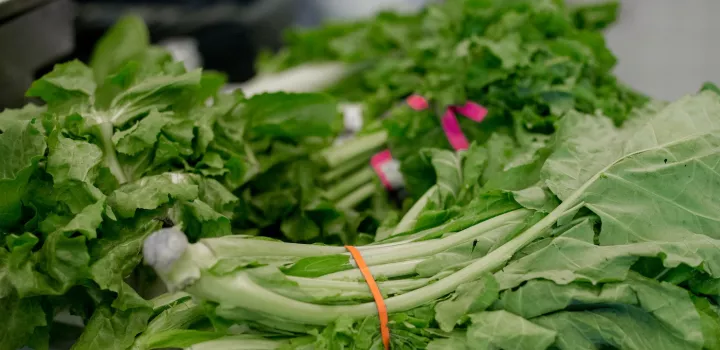
Why Hot Lettuce Should Be in Your Weeknight Routine
Use a wok and XO sauce to stray from salads with excess lettuce.
A few months ago, I picked up a CSA box filled to the brim with lettuce (and lettuce-like leafy greens). Romaine, red leaf, green, frisee, escarole – you name it. I came home, upended the entire box on my counter, and wondered how long it would take me and my husband to consume so much lettuce.
As someone who isn’t particularly fond of salads, the first few pages of Google yielded very few recipes that sparked my interest. Sure, I could make a half dozen versions of salad dressing, but I knew deep down it was unlikely I would make it past the first two. So I turned to trusty Instagram to gather ideas, captioning a short video of my 4-foot-long prep table covered with lettuce: “So … what should I cook with all this lettuce?” I sent the same note to my mother via WeChat, a messaging service popular among Chinese Americans.
My friend Alisha and my grandmother came to the same conclusion – and fairly quickly at that. “Hot lettuce!” I read from them both. “Wok-tossed lettuce, it’s the best!” Alisha said. “Cao yi cao!” (saute it!) my grandmother agreed. And with that, the technique was settled, which only left the question: What kind of sauce?
The easiest version would be a sprinkle of garlic, perhaps a spritz of sesame oil, too. But I seized the momentum of cooking lettuce for the first time (I never thought to heat lettuce before!) and ventured down the path of making XO sauce. Up until then, I had been too nervous to try my hand at XO, a legendary condiment hailing from Hong Kong, where it originated in the 1980s. It is named after the Cognac term XO (or “extra old”), to showcase the many rare and special ingredients that make up its layers of umami. (In fact, packaged XO sauce also uses Cognac-like branding and messaging in its marketing.)
As I’ve written about before, extracting and combining umami from different protein sources results in uniquely flavorful final products. In XO sauce, the base trio is generally dried scallops, dried shrimp and Jinhua ham (a dry-cured ham from the city of Jinhua in the Zhejiang province), alongside aromatics like onion, garlic and red chilies. It is delightfully chunky, offering a textural contrast alongside richly sweet and savory notes.
While XO is certainly not the only sauce you can put on sautéed or stir-fried lettuce, it will likely solidify your love for hot lettuce once you do have them together. With my own derivative of XO in the refrigerator, I find that even a dozen heads of lettuce can’t hold me over until Saturday. Just a quick chop, a very hot wok (or cast-iron or heavy-bottomed pot) lubricated with neutral oil (make sure to pick one with a high smoke point), and you’re well on your way to a fantastic side to eat with basically anything.
Every chef has their own XO recipe, so after gaining some comfort making more traditional recipes first, I forged ahead with some new modifications and additions. The below is my go-to recipe, now enough of a departure from the baseline XO I’ve dubbed it “umami sauce,” inspired by the principles of XO. Feel free to add your own changes to suit how you like to cook and eat (just don’t misrepresent your final product, please), and keep on spreading the virtues of hot lettuce and XO.
Recipe
Umami Sauce (an XO-Inspired Sauce)
Ingredients
- 20 grams dried shrimp
- 25 grams dried scallops
- 1 1/2 teaspoons whole coriander seed
- 1/2 teaspoon whole fennel seed
- 1/2 teaspoon whole caraway seed
- 5 dried red chiles (optional)
- 2 fresh bay leaves (optional)
- 2 cups neutral oil
- 4 ounces pancetta, diced
- 60 grams shallot, minced
- 20 grams ginger, minced
- 25 grams garlic, minced
- Soy sauce, as needed
- Maple syrup, as needed
- Fish sauce, as needed
- 1 cup unsalted chicken or dashi stock
- Kosher salt, as needed
- White sugar, as needed
- Vinegar of choice, as needed (I use white balsamic vinegar)
Directions
- Hydrate the shrimp and scallop in boiling water until softened, approximately 5 minutes.
- Strain shrimp and scallop and reserve liquid. Transfer to food processor and pulse 5-6 times or until mixture takes on a lightly stringy quality.
- Coarsely grind all spices.
- Heat oil in heavy-bottomed pot or wok until ~300 F. Lower heat to medium to medium-high.
- Add pancetta, and fry for 2-3 minutes or until golden brown.
- Add shrimp and scallops. Fry for another 3-5 minutes until medium brown.
- Add all spices, bay leaves, and red chiles and let fry 1 minute.
- Add shallot, ginger, garlic. Fry 2-3 minutes until golden brown.
- Add soy sauce, maple syrup, fish sauce, starting with ~2 tablespoons of each.
- Add chicken stock and reduce heat to medium.
- Let cook and bubble 10-15 minutes, or until most of the stock has evaporated.
- Taste and season with additional salt, sugar, and vinegar of choice.
- Remove from heat and let cool 10 minutes.
- Transfer to glass jars. For best results, let flavors meld overnight.
Read more about sauces and soups, and study global cuisine in Culinary Arts at ICE.


Shellfish substitute for XO Sauce
Submitted by Judi on September 16, 2020 11:45am
I need to avoid shrimp & scallops, can I use tuna, salmon or other fish?
I have never tested it with…
Submitted by aday on October 12, 2020 5:01pm
I have never tested it with any of that, but I think that the umami of fish sauce could be a decent substitute! — Chef Jenny
Add new comment